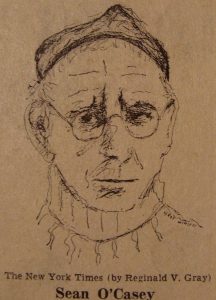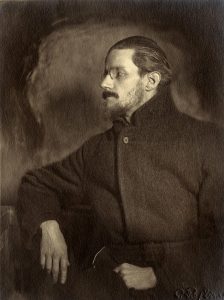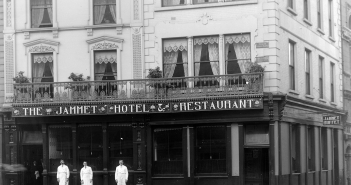In a powerful 1997 essay, Seamus Deane suggested that the twin forces that beset modern Irish writers such as W.B. Yeats and James Joyce were those of Apocalypse and Boredom.[1] Both the culture in which the writers lived and the art-works they produced are marked by phasic interruptions into colonial despondency of revelatory dramas and epiphanies:
In Yeats’s work–plays and essays, we may feel at times that a little boredom might be something of a relief from the constant appropriation of almost everything that happened in his lifetime to a visionary apocalypse in which all that is ‘past, or passing or to come’ flashes up in a conflagration that consumes time and exposes eternity. What I want to suggest here is the natural alliance between Joycean boredom and Yeatsian apocalypse in relation to temporality and therefore to history.[2]

‘visionary apocalypse’ W.B. Yeats. (c) Daniele Idini.
Deane’s proposal reflects something of the deadlock of revisionist and radical criticism in Irish Studies in the 1990s – a political deadlock which has largely passed into desuetude in the post-Good Friday atmosphere. If revisionism proposed a certain constitutional conservatism and was a bit of a bore, the radical cultural critics wielded a language which was apocalyptically difficult to understand in its more post-post-structuralist modes. And what was lost in the debate was something of the craic of ordinary people, and the points of cracked reality in ordinary life which do not succumb easily to academic enquiry.
Methodologically, of course, we find ourselves these days stretched across wide and strange territories of discourse and discipline, and at a very late stage in the drama of literary criticism from Leavis to Baudrillard. Contemporary criticism has a surfeit of entry points and elaborations, resembling a quantum field in its complexity. I could, whilst sticking only to a psychological theme, find many feminist responses to one essay in late Lacan. Or I could argue for yet another return to a missed aspect of a deconstructed Freud. I would prefer though to draw simple and broad brush-strokes which would not incite the total indignation of a casual reader. My psychological terms are broadly popular (the aesthetic terms are more or less commonly known in academia since Bakhtin). And the argument is willingly simple: that ‘Apocalypse and Boredom’ as a binary needs a mediating term (Crack) which turns out to be dizzyingly deconstructive in its implications. Modern scholars cannot either manoeuvre round or simply ignore this post-structuralist facet of a text but must, as Terry Eagleton has suggested, go through theory and out the other side. And wisdom is to be found in many places including the most demotic and the most abstruse. Our common language in the end must be the structures of wisdom, and Derrida has as much a claim to them as does the greatest ‘realist’ of a pub in Grafton Street. [3]
Deane’s broad historical binary can be broadened to include a psychological dimension and also an aesthetic principle for the detailed analysis of culture, society and art. The psychological dimension appropriate to Irish modernism, I shall argue, is manic-depressive in structure. The corresponding aesthetic principle is a principle of carnival-nihilism where the hyphen suggests an affinity with the related manic-depressive psychology. The hyphen should suggest that the prior term in each case (mania, carnival) is not necessarily adjectival but has also an intimate link with its sister terms depression and nihilism. Adding these terms to Deane’s we might produce a more complex matrix for the discussion of Irish modernism for there are fascinating dialogical correspondences between manic, carnivalistic and apocalyptic phenomena, as indeed there are between depressing, nihilistic and boring colonial experiences. In the process of thus broadening the terms of reference, we will discover the emergence of that third term which ironises the solemnities of apocalypse and boredom: the term known to our common culture as crack.
It is a question of corollaries of structure. Manic-depression is episodic and interruptive of quotidian life in the same way that apocalyptic and boring experiences can be said to be episodic diversions from the ‘normal’ functioning of a happy democratic culture. Mania wrecks routine, and depression makes us incapable of routine. The terms carnival and nihilism are not new, but in an internal relationship with each other they form an aesthetic principle which deforms the more staid genre of tragi-comedy which is often taken by older critics to represent an aesthetic ‘norm’ for representing the human condition.[4] Carnival, like mania, achieves a disruption of normal boundaries, hierarchies and empirical states of mind. Depression and nihilism can kill our sense of the value of the ordinary. Christian apocalypse disrupts boundaries (‘ye shall be as gods’), hierarchies (‘I am the Alpha and Omega’) and forms of empiricism ( ‘they shall see the Son of man coming in the clouds of heaven with power and great glory’). But it is also true that boredom can at its extreme give us an extremely interesting sense of what eternity might be like. In a Derridean sense each of these terms when pushed to its limit can turn into its opposite: there is nothing more boring than an over-long carnival, and nothing more likely to reveal ‘the hidden’ than a night of nihilistic visions.
The dialogical inter-action of these terms furnishes us with both ‘vertical’ and ‘horizontal’ opportunities if we imagine the structure thus:
Apocalypse Boredom (Socio-cultural level).
Mania Depression (Psychological level)
Carnival Nihilism (Aesthetic level).
Taken together as a matrix of six terms we can begin to be experimental, and the advantage of adding psychological and aesthetic terms is to furnish us with a complex language for discussing the contingencies of modernist culture: what, for instance, might a manic-nihilism resemble, say in the early Nietzschean plays of W.B. Yeats such as Where there is Nothing? Could we consider the possibility of a carnival of boredom in Joyce’s Dubliners or Brendan Behan’s The Hostage? How might a sense of apocalyptic depression inform Sean O’Casey’s The Silver Tassie? The terms are reversible, too, and this adds a further level of vocabulary to our exploration of forms: what is the function, for instance, of a depressive carnivalism in the plays of Samuel Beckett, a nihilistic apocalypse at the end of O’Casey’s Purple Dust and a boring mania in the work of Denis Johnston and Spike Milligan? I will now explore some of these terms more categorically and then go on to demonstrate how their presence can best be detected in the work of Sean O’Casey, a writer placed in the ‘minor’ category of modernists behind Joyce and Yeats, but who may come into his majority when seen as the first realist of crack.

Samuel Beckett, illustration by Malina/Artsyfartsy
- Mania.
In 1921, at the height of European modernism, the German psychiatrist Emil Kraepelin described manic depression for the first time as involving ‘a heightened distractibility’, a ‘tendency to diffusiveness’, and ‘a spinning out the circle of ideas stimulated and jumping off to others’. [5] In 1924 the Swiss psychiatrist Eugen Bleuler concurred and drew a parallel with artistic production:
The thinking of the manic is flighty. He jumps by by-paths from one subject to another, and cannot adhere to anything. With this the ideas run along very easily and involuntarily, even so freely that it may be felt as unpleasant by the patient….
Because of the more rapid flow of ideas, and especially because of the falling off of inhibitions, artistic activities are facilitated even though something worth while is produced only in very mild cases and when the patient is otherwise talented in this direction. The heightened sensibilities naturally have the effect of furthering this.[6]
We should notice the stress here upon the ‘heightened’ sensibility of the maniac for this reminds us of the heightened sensibility required to experience epiphany and revelation. We should also note the ‘falling off of inhibitions’ for this is a feature we will observe in our analysis of carnivalesque activity. The rapid flow and spinning of ideas also reminds us of some of the features we associate with modernist texts such as Ulysses. In short, the phenomenon of mania touches upon both frenetic literary activity and apocalyptic or transformative experience.
- Depression.
Seamus Deane refers in his essay to the ‘marks of boredom’ he detects in Joyce, Beckett and Kafka. They include:
– ‘dinginess of physical circumstance and dress’,
– ‘extreme routinization of action and speech’,
– ‘an individual eloquence that derives from consensual banalities’,
– ‘a sense of personal insignificance’ ,
– ‘the belief that one is … in a void ….’ [7]
Let us contrast this list with a list of depressive symptoms described by Irish psychiatrist Anthony Clare:
‘-Feelings of guilt or worthlessness
– Loss of concentration
– Loss of energy and noticeable tiredness of fatigue
-Suicidal thoughts …
-Agitation or marked slowing down (retardation’).[8]

Sean O’Casey, Image by Reginald Gray.
It is clear from these lists that clinical depression and cultural boredom are intimately related. As we shall see in the work of Sean O’Casey, the subject feels that he has been broken into pieces. It is an experience of extreme boredom as a form of disintegration which results, paradoxically, in a form of apocalyptic fear:
[The depressive] feels solitary, indescribably unhappy, as ‘a creature disinherited of fate’; he is sceptical about God, and with a certain dull submission, which shuts out every comfort and every gleam of light, he drags himself with difficulty from one day to another. Everything has become disagreeable to him; everything wearies him … he thinks he is superfluous in the world, he cannot restrain himself any longer: the thought occurs to him to take his life without his knowing why. He has a feeling as if something had cracked in him, he fears that he may become crazy, insane, paralytic, the end is coming near. (Italics inserted).[9]
Colonial depression is a much more disintegrative experience than the term ‘boredom’ allows. The depressive is opened up to extraordinarily painful inner confusion and despair as he ‘cracks’ under the strain of living a false life. The only redemptive feature of the experience lies in the fact that extreme depression can become a form of revelation of capitalism’s utter inner monotony. The depressive subject can become aware of his extreme oppression through his consciousness of his fractured personal moods. There is , also, as we shall see, something redemptive and ironical about that ‘crack’.
- Carnival.
So much has been written about carnival in recent decades that the term has sadly been recuperated as a ‘boring’ academic category. We can crack open the term however when we inflect it with an analysis of its relationship with mania and nihilism. The classic description of the function of carnivalism belongs to Mikhail Bakhtin:
The laws, prohibitions, and restrictions that determine the structure and order of ordinary, that is noncarnival, life are suspended during carnival…. All distance between people is suspended, and a special carnival category goes into effect: free and familiar contact among people.[10]
It is a characteristic feature of mania that the patient demonstrates a ‘loss of inhibitions, particularly sexual and social’ and displays an ‘infectious mood – humorous, jocose, euphoric.’[11] The maniac also enjoys breaking the boundaries of propriety- talking to people familiarly on the street, entering private property without permission, cocking a snook at policemen and authority figures. In a sense, we might think of carnival as a form of collective mania licensed by its social contract. The maniac is stigmatised because of his solitude- his actions are not very different from those of the carnival clown. ‘The basic principle of grotesque or Carnival realism’, writes Michael Bristol, ‘is to represent everything socially and spiritually exalted on the material, bodily level. This includes cursing, abusive and irreverent speech, symbolic and actual thrashing’ and so on.[12] The patient in a manic phase often dresses bizarrely, curses abusively and irreverently, thrashes around and confuses his own body with that of a god. Mania is, in a sense, a one-man carnival.
‘Carnival’, writes Bakhtin, ‘celebrates the shift itself, the very process of replaceability, and not the precise item that is replaced, Carnival is, so to speak, functional and not substantive. It absolutizes nothing, but rather proclaims the joyful relativity of everything.’[13] The maniac, remember, is identified by his infectious mood, flights of ideas, pressurised speech with fast punning and rhyming, loss of judgement and inhibition. The maniac, too, proclaims the joyful relativity of all relationships, concepts and objects. There are clear structural connections, then, between the forms of apocalypse, mania and carnival, and I would suggest that mania is the mediating element between the two apparently unconnected forms of apocalypse and carnivalism. In one grotesque twist, the Christian apocalypse is all about the burning flesh of men, and carnival too (L. carne) concerns the destiny of the flesh. We might indeed view the Last Judgement through one grotesque optic as a kind of carnival of revelation.
- Nihilism.
Nihilism is the rationalisation of boredom and depression. It is, as it were, the ideology of melancholy. Where people merely act bored or depressed, as in, say, Joyce’s Dubliners , there is at least hope that some relief might come from the pain of their condition. These characters are not committed ideologically to the notion that life is meaningless but are merely acting out the paralysis of a cycle of colonial history. Nihilism, however, perceives the permanent negation of teleology, divinity and broadly socio-spiritual meaning. It searches for the lethal nothingness at the heart of any project and proclaims this as its secret truth. In conjunction with carnivalism as part of the couplet carnival-nihilism, nihilism acts as a corollary to the depression in manic-depression though with an even greater sense of finality. Where the maniac is reduced, in time, to the horrible vacuousness at the heart of his euphoria, the carnival subject, too, comes to understand that his destruction of all actually existing social forms conceals a secret and permanent nihilism. Carnival cocks a snook at authority but conceals from itself the secret vacuousness of its activity. It is a good thing to place a king’s crown on an ass’s head but it is also a gesture of hatred towards norms. Nihilism is thus the darkest of the six terms with which we are approaching Irish modernism because it emerges from the very heart of parodic action. But, in a final redemptive twist, we shall see that nihilism can be dialogised by the comical. Too much nihilism is, simply, funny, as James Joyce illustrates in his ironic parody of Catholic hell in A Portrait of the Artist as a Young Man and as Samuel Beckett discovered in Waiting for Godot. [14] Several pages of doom and gloom can become amusingly intense. As we shudder at the crack of doom, we cannot help but be reminded of the craic.

‘I cannot enter the social order except as a vagabond.’ – James Joyce, 1904
The Crack.
To be cracked can mean, as we have seen, to be depressed to the point of madness, but to ‘have the crack’ can mean the opposite: to be infected with carnivalistic joy. A crack can be a fault-line from which revelation might arise (literally ‘a seismic event’ as Deane has it) or a blow inducing paralysis. [15] It is an ambivalent term which mediates between our six analytical terms thus:
Apocalypse Boredom
Mania Crack Depression
Carnival Nihilism.
Crack is the deconstructive term which mediates the transition from one side of the grid to the other. When apocalypse turns into boredom there must be a point at which a position is neither apocalyptic nor boring and I would suggest that the subject here acts like a manic-depressive. When mania begins to turn into depression the patient feels that he is cracking up in the manner described by Emil Kraepelin:
He has a feeling as if something had cracked in him, he fears that he may become crazy, insane, paralytic, the end is coming near. [16]
A post-apocalyptic culture can feel that the old moulds have been cracked but this can induce a morose fear for the future that can induce an anxious boredom. Contrarily, when a culture experiences the onset of an apocalypse it encounters heightened, euphoric feelings as in the 1916 rebellion where millennial fever gripped sections of the population of Dublin. As it becomes hypomanic society can have an almighty craic before its euphoria reaches its peak of revelation and collapses back into self-hatred and paralysis. Crack is therefore something of a pharmakon. A good night out in Temple Bar can be a ‘cure’ for depression, but the booze leaves us with a poisonous headache. A crack on the head from an Irish Brother can give us a poisonous hatred of authority, but can also cure us of all our idealism. Crack is undecided in its effects: both violent and creative, fun and pain, a break and a mould. It is a very archetype indeed of deconstruction, for what could be more ambivalent than a textual crack: a point where the text roars and collapses, enjoys and splits, surges and cleaves. At the very point where Beckett reaches his cracked vision of futility, we can’t help but begin to crack up. There is no craic where there is no crack. And there is no crack where there is no craic. In fact, the term is not just a pharmakon, but the very possibility of there being a pharmakon because there could not be a limit which could not crack, crack being the condition of its hymenicity.
Crack is a transitive term then but one which cannot sustain itself either as a form or a limit. We crack under pressure but then crack away at a solution. A crack in a cup is a pain but great craic if it causes our landlord to drop tea on his trousers. Ireland itself is cracked along its Ulster border, but the border itself is ‘crackers’. A crack cannot be a thing, by definition: but is certainly something. The crack may be Ninety in the Isle of Man, but the crackdown in the Dublin of 1916 was terrible.
Sean O’Casey and The End of the Beginning.
In the work of Sean O’Casey, nihilism is articulated as it emerges from the scandalous pranks of his exuberantly carnivalesque Dublin slum-dwellers. [17] As his work progresses through the years of modernism and civil war, his vision becomes increasingly bleak, so bleak, in fact that it becomes, in an ironic twist, comical. O’Casey’s work hovers in the space of ambiguity created by the word ‘crack’ which can represent both a fault or interruption in the smoothness of a quotidian continuum and a sense of comical social play (craic). ‘Mr O’Casey’, wrote Samuel Beckett, ‘is the master of knockabout in this very serious and honourable sense- that he discerns the principle of disintegration in even the most complacent solidities, and activates it to their explosion.’[18] O’Casey’s wilful destruction of empirical solidities impressed Beckett philosophically (it was entropic) but also because, to use a contemporary phrase, it cracked him up. O’Casey was at his most amusing when he was being nihilistic and achieved his greatest spasms of laughter from his creation of ‘spasms of dislocation’ in the art-work.[19] In his 1934 play The End of the Beginning, two characters, Darry Berrill and Barry Derrill set about the destruction of an Irish country house with great relish and, in the process, wreck themselves:
Darry falls down the chimney … there’ll be a nice panorama of ruin … nothin’ done but damage … I’m after nearly destroyin’ meself! [20]
The country house should be read as symbolic of an emerging De Valeran pastoralism which both O’Casey and Conor Cruise O’Brien took to be a disappointment.[21] ‘Our generation’, wrote O’Brien, ‘grew into the chilling knowledge that we had failed, that our history had turned into rubbish, our past to a “trouble of fools.”‘[22] O’Casey’s country house is an objective correlative of post- Free State Ireland’s paralysis in which his comedic pair stumble blindly about in a void:
Darry (shouting madly). Barry, Barry, come here quick, man! I turned the key of the tap too much, ‘n it slipped out of me hand into a heap of rubbish ‘n I can’t turn off the cock, ‘n I can’t find the key in the dark. (p. 41.)
O’Casey and O’Brien could agree upon the ‘heap of rubbish’ that Irish history had become. Typically, however, O’Casey intensifies the nihilism in the sub-text of the play until its atmosphere becomes apocalyptic:
I can’t do anything … I don’t know what to do …What in the Name of God has happened? … can you do nothin’ right! … God grant that it won’t be the end … Is the clock stopped? For God’s sake, touch nothing … It’s as dark as pitch in there … (pp. 21-30).
At the centre of Free State Ireland, O’Casey surmised, there lay a metaphysical darkness and his play establishes an atmosphere of cosmic doom throughout. Strangely, though the effect of the treatment is comical because his pair of clots are so endearing, reminding us of Laurel and Hardy as they crash into furniture, disappear up and down chimneys and knock cracks in the walls of the de Valeran dream. We cannot tell whether the apocalypse of nihilism is serious or part of the craic. ‘Can’t you find anything?’ asks Darry. ‘I can see nothing’ replies Barry, as the play reaches its climax (p. 24), but again, the effect is amusing in the manner of a cartoon where all the lights go out and we see just the cartoon rabbit’s eyes glowing in the dark. O’Casey is attempting a serious critique of his country’s post-apocalyptic (Easter 1916) boredom, but he discovers that boredom holds a potential energy within it which can explode into epiphanies of entropy, at which point he cannot decide whether to laugh or go mad. His culture is exhausted (‘not a drop left in it, not a single drop! What’re we goin’ to do n– …’) but hysterically explosive: ‘… He lets go of the rope, and runs over to the oil drum. Darry disappears up the chimney‘ (p. 33). For O’Casey, De Valeran Ireland is literally ‘cracked’, deformed in a vortex of nihilism and farce:
He turns and sees that Darry has disappeared.
Lizzie (speaking outside in a voice of horror). The heifer, the heifer!
Darry (calling out). Lizzie, Lizzie!
Lizzie rushes in as Darry falls down the chimney…. (p.33.)
The terms Apocalypse and Boredom are not adequate in their singularity to capture such ambivalencies. Boredom taken too far can rebound as a form of apocalyptic emptiness as in O’Casey’s work from 1923-34 where we encounter darknesses which take us beyond the merely paralytic state of Joyce’s Dubliners towards Beckettian nihilism. Apocalypse, too, can be strangely boring as we can note from my opening quotation where Seamus Deane speaks of the relief that we seek from Yeats’s constant revelations. We must seek mediating terms for the movement between Deane’s twin poles of analysis for, in the end, the terms begin to deconstruct one another. The first step in moving towards a more complex analysis is to introduce more specific psychological and aesthetic terms. The second step is to seek a mediating term for the deconstructive activity of this more complex matrix. In the term ‘crack’ we have a term which mediates the ambiguities of the deconstructive inter-actions of apocalypse, mania and carnival, boredom, depression and nihilism. Yeats and Joyce may have wanted Ireland to aspire to being an Attic culture, but I would wish to install Crack within Seamus Deane’s paradigm to remind us that Ireland was always, already, a very Antic country. [23]
[1] Seamus Deane, ‘Boredom and Apocalypse: A National Paradigm’ in Strange Country: Modernity and Nationhood in Irish Writing since 1970 (Oxford, Clarendon Press, 1997).
[2] Deane, Strange Country, p. 171. For a discussion of manic-depressive activity in the life of W.B. Yeats, see my ‘”Down Hysterica Passio”: The Mood Structures of W.B. Yeats’, Irish University Review vol. xxviii, no. 2, Autumn/Winter 1998, pp. 272-80.
[3] A very Derridean street name.
[4] See, for instance, David Krause, Sean O’Casey: The Man and His Work (London, MacMillan, 1960), pp. 86-89 and passim. ‘Carnival’ and ‘nihilism’ should be thought of as standing to the extreme left and right, as it were, of the traditional terms ‘comedy’ and ‘tragedy’. Where tragi-comedy suggests an organic genre in which its terms are nevertheless discrete, carnival-nihilism should suggest an aesthetic that is in creative contradiction with itself. For further discussion of the principle of carnival-nihilism, see my (unpublished) M. Litt. thesis, Ideology and Dramatic Form in the Plays of Sean O’Casey, 1922-46 (Oxford, Bodleian library, 1994).
[5] Emil Kraepelin, Manic-Depressive Insanity and Paranoia , trans. R.M. Barclay, ed. G.M. Robertson (Edinburgh, E&S Livingstone, 1921) in Kay Redfield Jamison, Touched with Fire: Manic Depressive Illness and the Artistic Temperament (New York , Simon and Schuster: Free Press, 1994), pp. 107-8. We might consider manic depression to be a ‘modernist’ illness in the way that some writers have conceived schizophrenia to be a ‘post-modern’ illness (see, for example, Frederic Jameson, ‘Postmodernism, or the cultural logic of late capitalism’, New Left Review, 146, pp. 53-92.) Where the schizophrenic patient loses touch with structures of space and time permanently, the manic-depressive experiences episodic disorientation. He is able to recuperate his identity, albeit tentatively, and thus retains a sense of ironic detachment from a self in crisis which a schizophrenic patient cannot since his very sense of self has collapsed into a permanent ‘flow’ of disorder.
[6] Eugen Bleuler, Textbook of Psychiatry, English ed. A.A. Brill (London, Macmillan, 1924) in Jamison, Touched with Fire, p 108. The reader is referred to Jamison, Touched with Fire, pp. 262-3 (Appendix A) for the fuller Diagnostic Criteria of Mania.
[7] Seamus Deane, Strange Country, p. 170.
[8] Spike Milligan and Anthony Clare, Depression, p. 35.
[9] Emil Kraepelin in Milligan and Clare, Depression, pp. 23-4.
[10] Mikhail Bakhtin, Problems of Dostoevsky’s Poetics, Theory and History of Literature, Vol. 8, trans., ed., C. Emerson (Manchester, Manchester University Press, 1984), pp. 122-3.
[11] Milligan and Clare, Depression, p. 38.
[12] Michael Bristol, Carnival and Theatre: Plebeian Culture and the Structure of Authority in Renaissance England (New York, Methuen, 1985), p. 22.
[13] Bakhtin, Problems, p. 125.
[14] See, for example, James Joyce, Portrait of the Artist as a Young Man (London, Minerva, 1992), pp.130-40 and Samuel Beckett, Waiting for Godot (London, Faber and Faber, 1965), pp.11-15.
[15] Deane, Strange Country, p. 170.
[16] Emil Kraepelin in Milligan and Clare, Depression, pp. 23-4.
[17] See, for instance, Sean O’Casey, ‘The Silver Tassie’, Collected Works vol. ii (London, MacMillan, 1967) where a carnivalesque opening of great joy mutates into a despairing nihilism: The sound of a concertina playing in the street outside has been heard, and the noise of a marching crowd…. Shouts are heard– ‘Up the Avondales!‘ ; ‘Up Harry Heegan and the Avondales!’ Then steps are heard coming up the stairs, and first Simon Norton enters, holding the door ceremoniously wide open to allow Harry to enter … carrying a silver cup joyously…. (p. 25).
cf.:
Teddy: Strain as you may, it stretches from the throne of God to the end of the hearth of hell.
Simon. What?
Teddy. The darkness. (p. 89).
[18] Samuel Beckett writing about The End of the Beginning in ‘The Essential and the Incidental’, Thomas Kilroy, ed., Sean O’Casey: Twentieth Century Views (London, MacMillan ,1975), p. 167.
[19] Beckett, ‘The Essential and the Incidental’, p. 168.
[20] Sean O’Casey, ‘The End of the Beginning’, Five One Act Plays (MacMillan, 1990), p. 33. Further references to this play can be found in the text.
[21] This pastoralism would later produce the De Valeran vision of a countryside ‘bright with cosy homesteads, whose fields and villages would be joyous with the sounds of industry, the romping of sturdy children, the contests of athletic youths, the laughter of maidens; whose firesides would be the forums of the wisdom of serene old age.’ (Eamon De Valera quoted in David Krause, intro., Cock-a-Doodle Dandy (London, MacMillan, 1991), pp. 15-16. In Cock-a-Doodle Dandy , O’Casey developed the point made in The End of the Beginning– that the boredom of pastoralism concealed an apocalyptic force (the cock) which could rip its pretensions apart.
[22] Conor Cruise O’Brien, ‘The Embers of Easter’, O.D. Edwards and F. Pyle, ed.s, 1916: The Easter Rising (London, MacMillan, 1968), p. 231.
[23] For an interesting essay on the relationship between antics and melancholy, see Harry Levin, ‘The Antic Disposition’, Hamlet: A Selection of Critical Essays, ed. John Jump (London, MacMillan, 1968), 122-36. The word antic derives etymologically from the Italian antico (antique) which gives the phrase ‘Antic country’ a satisfyingly Yeatsian accent.




